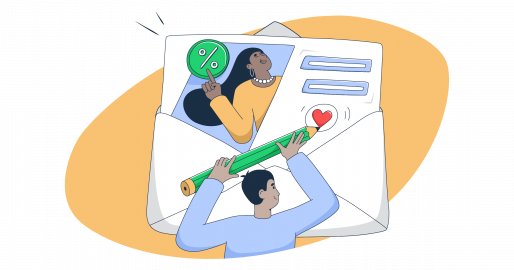I used to think that a strong copy alone was enough to drive engagement, but over time, I’ve realized that the email header design, which is what gives subscribers the first impression, is equally important to help people make up their minds in the first few seconds.
So, in this tutorial, I’ll share everything you need to know about email headers, from ideas and examples to best practices.
Email header design requirements
Let’s start off with some design tips to help you create an effective email header.
Recommended email header size and dimensions
Although there’s no one-size-fits-all rule for header size, these guidelines have worked well for me across a lot of email header templates:
| Spec | Recommended range | Explanation |
| Width | 600–700px | Standard for most email clients, as it keeps the header consistent across devices. |
| Height | 70–200px | Keeps the focus on the content without pushing it too far down. |
| Header images | Under 300KB (max 1MB) | Loads the email quickly and avoids display issues. |
Over to you: We have a dedicated article on maximum email size and how to optimize it. 👀
Key elements of an email header
A professional email header should clearly reflect your brand and make it easy for readers to jump in. So, depending on your email goal, here are some essentials you may want to include:
- Brand logo or name for instant recognition.
- Simple navigation (e.g., “Shop” or “Blog”) if it’s a newsletter header.
- A short hook that supports your subject line.
- A call to action (CTA) if you want to encourage clicks right from the top.
- A subtle background color or image to make it visually engaging, but keep it clean and avoid distractions.
Mobile responsiveness
Avoid fixed header heights because they may look fine on your desktop device but may appear misaligned on cell phones or tablets. And let’s be honest: a great deal of people open their emails on mobile devices nowadays.
So, use fluid design blocks because they adjust automatically based on the screen size, which maintains visual consistency.
How to design an email header
There are two main ways to build a good email header. One’s quick and simple; the other gives you full control.
Option 1. Customize the email template
If you want to save time without sacrificing style, use pre-made email templates. You can easily tweak the logo, colors, and layout to match your brand without any coding skills or HTML knowledge.
Option 2. Design from scratch
If time is not the issue for you, if you prefer to do everything yourself and want to have full control over the creative process, you can use an HTML email builder:
- Set your canvas: Start with a 600–700px wide layout for compatibility across email clients.
- Add your logo: Place it top-left or center for quick brand recognition.
- Pick a clean background: Solid colors or subtle patterns work best, and avoid anything too loud or shiny.
- Insert a headline or message: Keep it short and aligned with your email’s purpose (e.g. “50% Off on All Products” for a fashion brand’s discount launch).
- CTA: Add a simple call-to-action (optional).
- Make it responsive: Use flexible layout blocks that adapt on mobile without fixing heights.
Email header design examples and templates
Now let’s look at some email header examples to understand how you should approach yours.
1. Minimalist and bold email header design
This template example keeps things simple with a bold red and white background, clean text, and a high-contrast layout that immediately grabs attention. The headline Stay Connected is short, clear, and encourages readers to take notice.
2. Basic but sleek email header design
This example from Sephora nails the balance between aesthetics and strategy. Right at the top, you can see their famous logo, and next to it is a simple navigation bar which links to popular sections like “Makeup” and “Skincare.” That makes it super easy for users to go straight to what they want.
And the fun, casual headline Hey Good Lookin’ sets a friendly tone right from the start.
3. Bright and promotional email header design
This vibrant header from PosterMyWall is perfect for a high-energy promo. The green and yellow colour scheme shouts summer vibes, while bold CTAs like Up to 80% Discount and Exclusive Offer get the message across instantly.
Email header design ideas & inspirations
If you’re still feeling a bit stuck, don’t worry. Here are a few quick ways to get fresh ideas and start your email header design:
- Subscribe to competitor email newsletters known for excellent marketing.
- Search for inspiration on Pinterest with keywords like “email header design” to get tons of trendy visual ideas.
- Explore and use email design tools to search for pre-built header templates for an initial idea and customize them according to your email campaign goal and brand colors.
Email header design tools
You don’t have to be a pro to create an email header design that converts. What you need are the right tools:
1. Postcards by Designmodo
Postcards, developed by Designmodo, is a drag-and-drop email builder and an extensive library of pre-made templates, which you can customize to create your email headers within minutes.
- Top features: Drag and drop builder, pre-made email templates, export to major email platforms
- Pricing: The starter plan is free, the plus plan costs $16/month, and the pro plan costs $28/month
- Best for: Designers, agencies, developers, and even beginner-level marketers who want flexibility with less to no coding
2. Canva
Canva provides multiple templates to help you create visuals and generate creative ideas.
- Top features: Drag-and-drop editor, branded kits, image library
- Pricing: Free version is available, and the Pro plan starts at $55/user
- Best for: Individuals, freelancers, or marketers who are not experts in designing
3. Mailtrap Email Sandbox
Email Sandbox lets you inspect and debug emails in staging, dev, and QA environments before sending them to recipients.
- Top features: Email preview, spam score checker, inbox testing
- Pricing: Free version is available, and the basic plan costs $15/month
- Best for: Developers, QA teams, and email marketers who focus on deliverability and consistency
4. Figma
Figma is a professional-level design tool for creating highly customized email header designs.
- Top features: Real-time team collaboration, design systems, component libraries, vector editing
- Pricing: Free with limited functionality, and the professional plan starts from $5/month
- Best for: Since it has a steep learning curve, it is most suitable for experienced designers who want pixel-perfect control and collaboration features.
Email header design best practices: Checklist
I’ve listed some easy-to-follow practices used by the best in the business you can follow to make sure you design eye-catching email headers.
Use brand colors strategically
Brand consistency contributes to 10-20% of revenue growth. And color is a major part of your brand’s identity, which maintains consistency in all marketing materials.
For those in the early stages of building a brand, there’s room, and even value, in experimenting with your color scheme. At Selfnamed, we’ve seen new skincare brands use this flexibility to gradually shape a visual identity that feels cohesive across their packaging, website, and emails, rather than locking into one too early.
– Daria, Marketing expert at Selfnamed
Think of Spotify’s green or Coca-Cola’s red; they instantly feel familiar. So, use your brand colors in the same way to create consistency across emails, websites, and social media channels.
Add a visual hierarchy
Visual hierarchy guides your readers from your logo to the headline and your CTA or navigation links. You need to design it strategically to provide a user-friendly experience and make your reader’s focus remain on the email’s main content.
Here is a formula for a smooth visual hierarchy for an email header:
(Logo → Headline → CTA/Navigation link)
For example, Sweaty Betty used a minimalist header design in this email that shows mostly their logo and a clear navigation menu.
Source: Sweaty Betty
Avoid image-only headers
Images can fail to load or may not be accessible to all users. So use HTML-based designs with styled text and ALT text to make sure your message still comes through, no matter what.
Test on all devices
Your email might look perfect in Gmail, but what about Outlook, Apple Mail, or other random Android mail apps? Each email client renders code differently, so a perfect header on one could break on another.
To avoid this, use tools like Mailtrap to preview and test your emails across devices and clients so your design shows up exactly as you intended on all devices.
Include fallback fonts
I always recommend defining fallback fonts just in case the user’s device doesn’t have the preferred font installed within the email content.
Fallback fonts help you to keep your design clean and legible. I’d also suggest sticking to reliable font stacks like Helvetica, Arial, sans-serif, Georgia, Times, and serif to ensure consistency across email clients.
Optimize load speed
Slow-loading emails can kill engagement, so make sure to compress your header images using tools like TinyPNG to reduce file size without losing quality. You can also use vector graphics (SVGs) for sharp visuals at smaller sizes or consider lazy loading for heavier assets.
Link header elements
Link header elements like logos directly to the right landing pages to boost your user experience. You can generate a logo that should take users to the homepage to get more website traffic, whereas CTAs should lead to relevant pages that align with your email or website content.
You can also place UTM parameters on these links to get detailed analytics and measure the performance of your email marketing strategy. It will also help you track UX as you can create heatmaps of how users navigate through your emails, from the headline to the buttons.
Personalize where possible
Go beyond names and add dynamic elements like location or product recommendations. In fact, one brand, Doggyloot, saw a 750% boost in click-throughs by personalizing emails based on pet info.
What’s next?
And there you have it folks, we’ve come to the end of our email header design checklist!
However, an email header is only a part of the bigger picture, that is, a complete email design. Luckily, we’ve got a plethora of articles on the topic, such as:
- Responsive Email Design Templates
- HTML Email: A Complete Tutorial
- Responsive HTML Email Template Development
- Email Design Trends: What to Expect and How to Stand Out
Or, you can also check out how to make AI to the heavy lifting for you and design emails in your stead!


